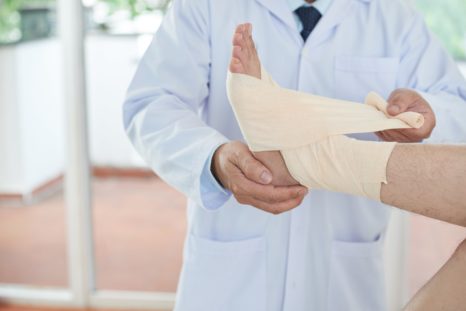What is Morton’s Neuroma?
Simon Moyes discusses what Morton’s Neuroma is, how it can be diagnosed and what non-surgical treatments can help.
Morton’s Neuroma is a condition which affects the nerves in the foot that run between the metatarsal heads.
Although the exact cause is unknown, it is generally observed that the interdigital nerves – most commonly involving the third and fourth toes – get pinched as we walk. This trauma to the nerve causes them to swell, generating a vicious cycle of more pain, clicking, swelling and altered sensation.
If you wear high heels or tight-fitting shoes, you will be more likely to irritate the nerves causing enlargement and swelling. You will also be prone to Morton’s Neuroma if you have suffered a recent injury or trauma to the foot.

Patients with Morton’s Neuroma will typically feel a severe aching pain in the ball of the foot, which will be akin to ‘walking on a marble’. Patients will also feel a sharp pain between the bones of the affected toes, which may be prone to clicking, periods of numbness and sometimes electrical type pain shooting through the affected toes.
In order to diagnose the condition properly, the surgeon will carry out a detailed analysis of the foot in order to determine if the pain is being triggered by any other factors, such as stress fractures in the bones or bunions or any biomechanical issues. A careful examination of the foot is performed by the surgeon as there are two or three specific clinical tests for the condition.
An ultrasound or MRI scan will be carried out to confirm the diagnosis, assess the size of the lesion and exclude other problems. It may also be necessary for the surgeon to test the way the foot moves in order to determine that arthritis or joint inflammations are not the primary cause of pain.
Morton’s Neuroma can be treated with non-surgical procedures such as:
- Wearing wider fitting shoes with smaller heels. Doing so will allow the toes to spread out and ease the level of pressure placed on the digital nerve – this will speed up the healing process.
- Using tailor-made inserts in shoes to reduce pressure on the nerve
- Injecting corticosteroid to reduce inflammation and provide pain relief.
These non-surgical procedures work in the majority of cases.
If the foot does not respond to any of the above treatment, minor surgery will be necessary.
Surgeons will typically use the Dorsal Approach for treatment. This will involve the surgeon making an incision in the top of the foot, to allow for the surgical instruments to navigate easily through the foot in order to expose the nerve and remove the Neuroma.
Surgery is performed as a day case. Patients go home same day with a pressure dressing on their foot, which is normally removed after 3 or 4 days. Stitches are removed after 10 days, at which point patients can start retuning to loose, comfortable footwear.
Patients will be able to walk very soon after surgery because the stitches are not on the underside of the foot.
Simon Moyes is an internationally renowned orthopaedic surgeon. His Capital Orthopaedics team works at Basinghall Clinic in London, with its state-of-the-art diagnostic and surgical equipment, and top sports medicine professionals. Contact Simon Moyes for an expert diagnosis and treatment of foot injuries.
